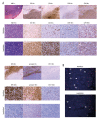Bilineal Extramedullary Blast Crisis as an Initial Presentation of Chronic Myeloid Leukemia: A Case Report and Literature Review
- PMID: 27784881
- PMCID: PMC5085336
- DOI: 10.12659/ajcr.899621
Bilineal Extramedullary Blast Crisis as an Initial Presentation of Chronic Myeloid Leukemia: A Case Report and Literature Review
Abstract
BACKGROUND Chronic myeloid leukemia (CML) is a clonal myeloproliferative disorder characterized by the Philadelphia chromosome generated by the reciprocal translocation t(9: 22)(q34;q11). CML is usually diagnosed in the chronic phase. Blast crisis represents an advanced phase of CML. Extramedullary blast crisis as the initial presentation of CML with bone marrow remaining in chronic phase is an unusual event. Further, extramedullary blast crisis with T lymphoid/myeloid bilineal phenotype as an initial presentation for CML is extremely unusual. CASE REPORT Here, we report the case of a 49-year-old male with rapidly enlarged submandibular lymph nodes. Biopsy specimen from the nodes revealed a characteristic appearance with morphologically and immunohistochemically distinct myeloblasts and T lymphoblasts co-localized in 2 adjacent regions, accompanied by chronic phase of the disease in bone marrow. The presence of the BCR/ABL1 fusion gene within both cellular populations in this case confirmed the extramedullary disease represented a localized T lymphoid/myeloid bilineal blastic transformation of CML. After 3 courses of combined chemotherapy plus tyrosine kinase inhibitor treatment, the mass was completely regressed with a 3-log decrease in BCR/ABL1 transcript from baseline. Five months after the diagnosis, the patient showed diminished vision, hand tremors, and weakness of lower extremities. Flow cytometric immunophenotyping of cerebrospinal fluid revealed the presence of myeloid blasts. An isolated central nervous system relapse of leukemia was identified. Following high-dose systemic and intrathecal chemotherapy, the patient continued to do well. CONCLUSIONS The possibility of extramedullary blast crisis as an initial presentation in patients with CML should be considered. Further, an isolated central nervous system blast crisis should be considered if neurological symptoms evolve in patients who have shown a good response to therapy.
Conflict of interest statement
Conflicts of Interest: None declared
Figures


Similar articles
-
Mixed phenotype (T/B/myeloid) extramedullary blast crisis as an initial presentation of chronic myelogenous leukemia.Exp Mol Pathol. 2018 Apr;104(2):130-133. doi: 10.1016/j.yexmp.2018.02.005. Epub 2018 Mar 1. Exp Mol Pathol. 2018. PMID: 29501750
-
Chronic Myeloid Leukemia with cryptic Philadelphia translocation and extramedullary B-lymphoid blast phase as an initial presentation.Acta Biomed. 2018 Apr 3;89(3-S):38-44. doi: 10.23750/abm.v89i3-S.7219. Acta Biomed. 2018. PMID: 29633732 Free PMC article.
-
T lymphoid/myeloid bilineal crisis in chronic myelogenous leukemia.Exp Hematol. 1993 Jun;21(6):743-8. Exp Hematol. 1993. PMID: 7684698
-
Ph-negative non-Hodgkin's lymphoma occurring in chronic phase of Ph-positive chronic myelogenous leukemia is defined as a genetically different neoplasm from extramedullary localized blast crisis: report of two cases and review of the literature.Leukemia. 2000 Jan;14(1):169-82. doi: 10.1038/sj.leu.2401606. Leukemia. 2000. PMID: 10637493 Review.
-
Extramedullary Blast Crisis of Chronic Myelogenous Leukemia With a Skin Lesion: A Case Report and Literature Review.Am J Dermatopathol. 2021 Jun 1;43(6):450-453. doi: 10.1097/DAD.0000000000001897. Am J Dermatopathol. 2021. PMID: 33481378 Review.
Cited by
-
Multiparametric Flow Cytometry in Mixed Phenotype Acute Leukemia.Indian J Hematol Blood Transfus. 2019 Jul;35(3):451-458. doi: 10.1007/s12288-019-01101-0. Epub 2019 Feb 13. Indian J Hematol Blood Transfus. 2019. PMID: 31388256 Free PMC article.
-
Redistribution, homing and organ-invasion of neoplastic stem cells in myeloid neoplasms.Semin Cancer Biol. 2020 Feb;60:191-201. doi: 10.1016/j.semcancer.2019.07.025. Epub 2019 Aug 10. Semin Cancer Biol. 2020. PMID: 31408723 Free PMC article. Review.
-
Gemtuzumab-ozogamicin and blinatumomab as treatment for refractory mixed-phenotype blast crisis in chronic myeloid leukaemia.BMJ Case Rep. 2021 Nov 11;14(11):e243745. doi: 10.1136/bcr-2021-243745. BMJ Case Rep. 2021. PMID: 34764108 Free PMC article.
References
-
- Bartram CR, de Klein A, Hagemeijer A, et al. Translocation of c-ab1 onco-gene correlates with the presence of a Philadelphia chromosome in chronic myelocytic leukaemia. Nature. 1983;306(5940):277–80. - PubMed
Publication types
MeSH terms
LinkOut - more resources
Full Text Sources
Medical
Research Materials
Miscellaneous

